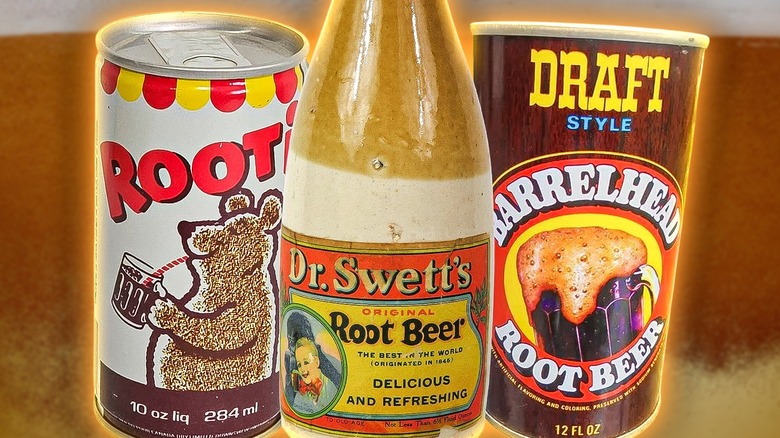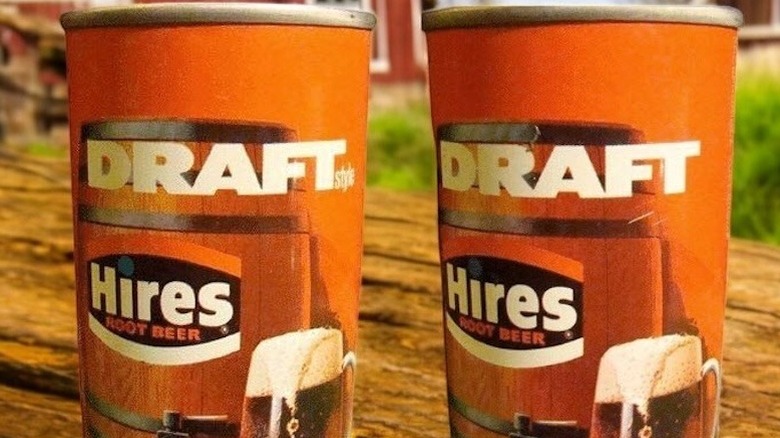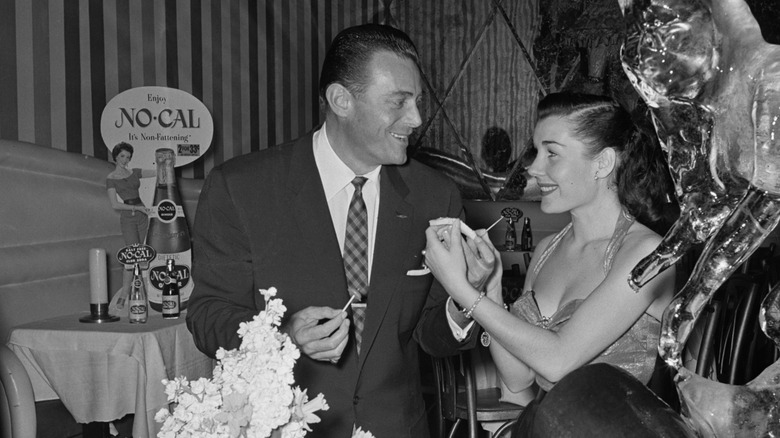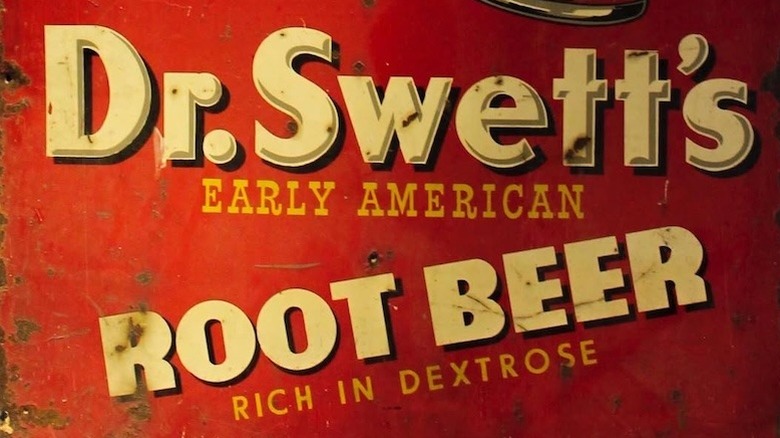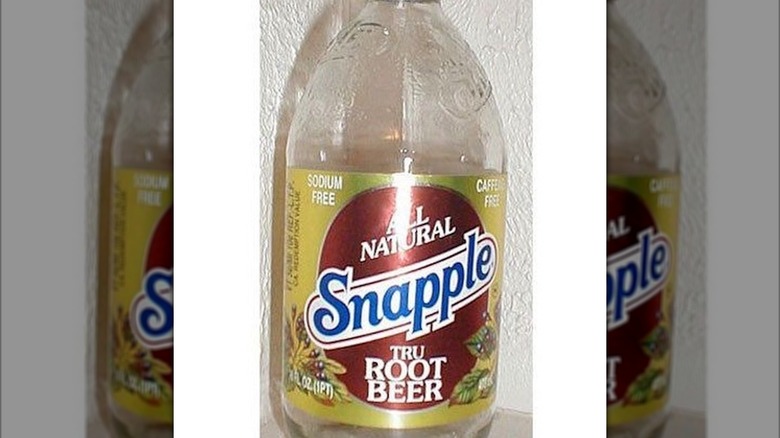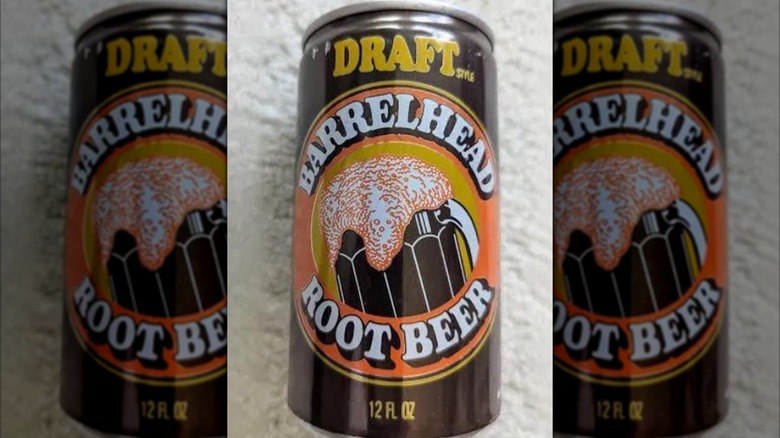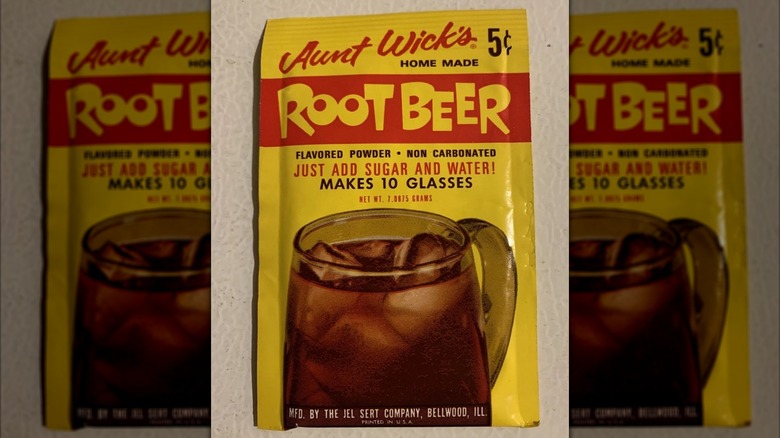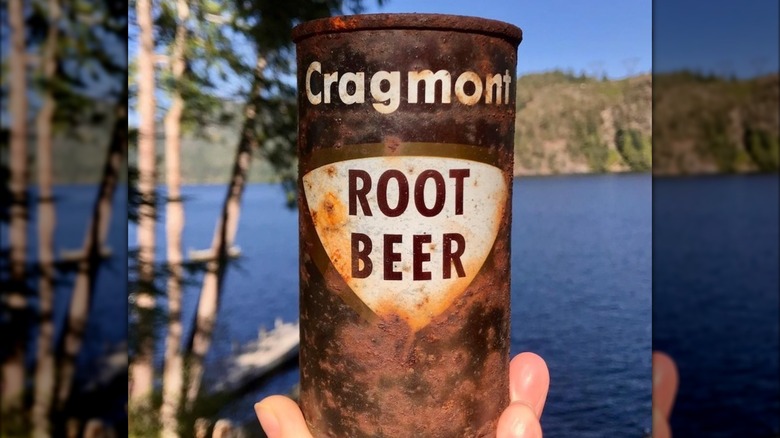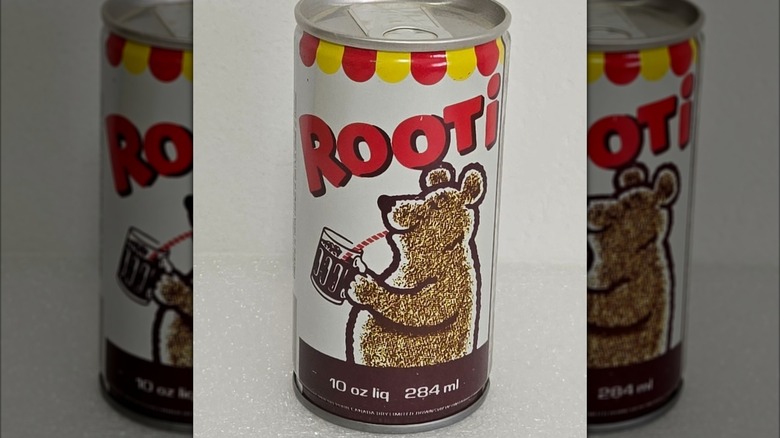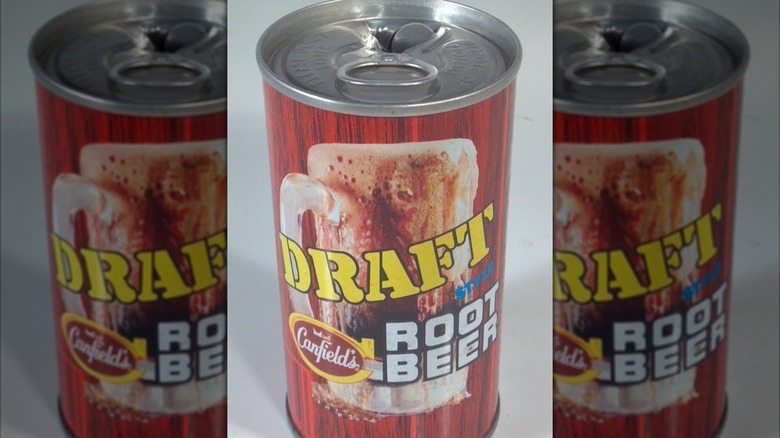Discontinued Root Beers We'll Probably Never Drink Again
We may receive a commission on purchases made from links.
Everyone knows that the best root beer is perfectly sweet and spicy, ideally, as sweet as its distant cousins in the cola sector, but with a kick, along with a blend of flavors. (And a splash of vanilla certainly doesn't hurt.) Despite the name, root beer never actually contained alcohol, it was just reminiscent of the harder stuff due to its layered taste and the fact that it required many ingredients to be correctly brewed. Today's root beer is missing what was once a signature ingredient, sassafras, banned by the FDA in the mid-20th century for its potential carcinogenic effects.
Long before and long after colas and lemon-lime drinks conquered the hearts, minds, and preferences of most soda fans, root beer entrenched itself as an all-time classic. Throughout the 19th and 20th centuries, the root beer market was robust and prolific, with different brews of varying strengths and flavor profiles competing for the love of the public. They didn't all make it, on account of changing tastes, industrial consolidation, and the inability to use once prominent ingredients. Here are a bunch of fondly remembered root beer brands that have disappeared, probably forever.
Hires
While drinks made with ingredients like spruce and birch extracts, burdock, yellow dock, dandelion, and sassafras were consumed for centuries, Charles E. Hires took credit for inventing the modern incarnation of root beer when he introduced his packets in 1876. Selling his "Greatest Health-Giving Beverage in the World" (per "The Oxford Companion to American Food and Drink") at the Centennial Exposition in Philadelphia, Hires offered a blend of 16 herbs, roots, berries, bark extracts, and yeast that customers were instructed to brew (or ferment) into root beer at home.
By 1884, Hires had moved into root beer concentrates (for personal use), syrups (at pharmacy soda fountains), and bottled beverages. The latter was particularly successful, and by 1892, he had achieved annual sales of three million bottles, making his the biggest and earliest major root beer brand, predating A&W, Dad's, and Barq's.
Eventually, a sassafras ban led to a Hires reformulation. In 1962, fruity soda maker Crush International bought Hires' business, before being sold to Procter and Gamble in 1980, who in turn unloaded it to Cadbury Schweppes in 1989. It's now a division of Keurig Dr Pepper, which also controls a much more famous root beer brand, A&W. Choosing to favor that beverage, Hires root beer was phased out by the early 2010s.
Ramblin' Root Beer
In 1979, the vast and mighty Coca-Cola empire sought to expand its dominion into the classical, non-cola sector of root beer. That year, it started slowly rolling out what could very well have been a formidable competitor to the likes of A&W and Dad's, since it would have the distribution and marketing might of the biggest soda brand in the world. Ramblin' Root Beer earned rave reviews in the test marketing phase, with respondents calling out its remarkable effervescence and a taste akin to the homemade root beers of long ago, with strong notes of caramel and vanilla.
Coca-Cola heavily advertised Ramblin' Root Beer, and the product was available in cans, bottles,§ and at fast-food soda fountains throughout the 1980s. Eventually, it started to drop off, before disappearing from the marketplace entirely in the mid-1990s. That's when Coca-Cola bought Barq's, the most iconic drink of the state of Mississippi, and phased out the sweet and simple Ramblin' in favor of spicy, old-fashioned Barq's. A reformulated version of Ramblin' Root Beer made with real sugar appeared sometimes in specialty soda shops in the 21st century, but the original Ramblin' has long since rambled out of existence.
No-Cal Root Beer
"Diet" or "zero sugar" sodas are commonplace to the point of being taken for granted today, but the concept of a sugar-free soft drink was first floated in 1952. Brooklyn soda maker Hyman Kirsch took a job at the Jewish Sanitarium for Chronic Disease, and, influenced by the fact that the patients were coping with heart problems and diabetes, he invented a drink without the empty calories and sugar requisite to all the other sodas. Kirsch and his son developed a line of four sodas that weren't just sugarless, but also came in underrepresented flavors, like chocolate, black cherry, ginger ale, and root beer.
No-Cal was marketed only to diabetics and the health-conscious, as Kirsch was convinced that his market was limited to those groups. It sold only moderately well in the 1950s and 1960s, with No-Cal root beer and its other flavors the only option available for the target audience, until Coca-Cola and Pepsi came out with no-sugar colas. Once Tab and Patio (later renamed Diet Pepsi) hit the scene, No-Cal root beer was on borrowed time. The banning of its non-caloric sweetener, cyclamate, in 1970 for its potential to cause cancer hastened the end of No-Cal.
Dr. Swett's Root Beer
Despite a deeply unfortunate and unappetizing name that likely reminded potential customers of a bodily fluid, Dr. Swett's Root Beer persisted as a popular soft drink brand for more than a century. In 1836, Dr. George W. Swett, an entrepreneur who ran two large retail pharmacy operations in New York and Boston, started selling a mix for medicinal root beer. Made with sarsaparilla, checkerberries, wintergreen, and juniper, Dr. Swett's customers were instructed to brew the root beer with their own equipment and use the drink to treat minor ailments of the liver, stomach, and kidneys.
The powders proved so popular that Dr. Swett made a syrup from the same recipe and mixed it with soda water for sale by the glass at soda fountains in his pharmacies. By the early 20th century, Dr. Swett's was available at other pharmacies and pre-mixed in bottles. It was a nationally distributed brand, packaged by franchised partners until the 1950s. Dr. Swett's stood out from its competition with premium products, like fancy ceramic mugs and beer steins bearing the company name and artwork imitating that of ancient Greece.
By the late 1940s, Dr. Swett's was focusing more on a similar drink called Early American Root Beer, which eventually broadened to Early American Beverage. By the end of the next decade, the beverage in all its varieties had slowly stopped being produced.
Snapple Tru Root Beer
Back before Snapple reached its commercial and cultural peak as a national brand in the early 1990s, it liked to get experimental. In the early 1980s, when it mainly served the northeastern United States, Snapple audaciously unveiled a few sodas to its line of glass-bottled juices and tea blends. Among those carbonated Snapple variants were French Cherry, Cherry-Lime Rickey, and Tru Root Beer.
Presented as a more naturally made root beer, perhaps as a throwback to the beverage's heyday of a century earlier, Snapple Tru Root Beer was surprisingly not brown. Instead, it was completely clear while still carrying the distinctive and unmistakable herbal-meets-spicy taste of root beer — albeit with a strong taste of licorice — but without any caffeine and much less sugar than the competition. Never a runaway hit, Snapple likely discontinued Tru Root Beer at some point after the late 1990s, with no current plans to bring back the drink, despite addressing it by name on its FAQ page.
Barrelhead
Around the same time that it started selling Rooti Root Beer, Canada Dry came out with a markedly different root beer based on another recipe. Barrelhead hit stores in 1971 with a promise of a taste and consistency similar to a draft root beer, and a flavor far bolder than other soft drinks sold at the same time. After a test market just over the border in Buffalo, New York, produced favorable results, Canada Dry sent cans of Barrelhead all over the United States in 1975, with a massive TV and radio marketing blitz to the tune of $16 million a year.
Just six years later, the Dr Pepper Company bought Canada Dry and all its brands. As it already had some root beer producers in its portfolio, it stopped making Barrelhead, which had never turned into a major player anyway. By 1993, Barrelhead had been completely phased out of production.
Aunt Wick's
The Jel Sert Company (a phonetic portmanteau combining "gelatin" and "dessert") makes several shelf-stable dessert and drink mixes, like Wyler's, Skittles and Starburst powders, Otter Pops, and Dove pudding. The company got its start making much the same products back in 1926. A Chicago-based family business now in its fourth generation of internal ownership, one of Jel Sert's most famous and popular products was a root beer mix, named after one of its founders.
Aunt Wick's Root Beer was similar to the root beer powders sold in sealed packets or envelopes in the late 19th and early 20th centuries. At its most commercially visible peak in the 1970s, Aunt Wick's Root Beer was a finely pulverized combination of roots, spices, and flavoring agents. Consumers were supposed to add sugar and water to make two quarters of a non-carbonated, root beer-flavored drink similar to Kool-Aid, but spicier.
Aunt Wick's is no longer produced by Jel Sert, but the company still makes a root beer blend. It's a powdered, non-carbonated drink mix based on the flavors of Dad's Root Beer.
CragMont Root Beer
Beginning in the 1960s, the prominent supermarket chain Safeway offered an extensive and exclusive selection of sodas to its customers. Alongside the name brands, Safeway's in-store CragMont brand appeared on about two dozen different flavors of soda pop. Many, like Chocolate Mint and Strawberry Soda, didn't have a major label equivalent. One of the first and longest-lasting varieties of CragMont soda sold was its root beer. A very similar recipe was used for Diet CragMont Root Beer, although it was made without sugar.
In the 1990s, Safeway stores revamped their many private labels. In favor of embracing a new umbrella Signature Select brand for its house generic items, the grocery chain eliminated many of its long-standing lines, including CragMont soda. As of 2025, Safeway's Signature Select line of sodas lacks the breadth and variety that CragMont had. Nevertheless, it still makes a generic root beer, sold in cans and two-liter bottles, which serves as the successor and replacement for CraigMont's root beer flavor.
Rooti
Throughout soft drink history, a lot of the same companies that made ginger ale also made root beer. The beverages are similar in that they both rely on a combination of sweetness and spiciness, as well as naturally-derived ingredients, once said to alleviate light health complaints of the gastrointestinal variety. Root beer used various barks, while ginger ale (or ginger beer) utilized the power of ginger. To that end, in 1968, one of the best-known names in ginger ale expanded into the root beer sector with a drink called Rooti.
Sold only in 10-ounce metal cans (adorned with a root beer-sipping bear or panda) and never in bottles, Rooti didn't bear its parent company's trusted name until 1975, and even then only briefly. A year later, it underwent another change from Canada Dry Rooti Root Beer to just Rooti Root Beer. The end of 1976 also marked the end of the short life of Rooti. The root beer section was already quite crowded by that point and couldn't sustain another brand, even though Rooti's taste was supposedly much stronger than other, better-known soft drinks of the time.
Ol' Smoothie
Not to be confused with prepared smoothies purchased at the grocery store, Ol' Smoothie was a root beer brand produced and distributed primarily in the upper Midwest for a large chunk of the late 20th century. In 1953, the five Nelson brothers who ran the bottling plant in Pine City, Minnesota, that was contracted to make Coca-Cola and 7-Up products, wanted to add a root beer to the catalog of offerings. Rather than partner with an existing brand, they made their own after a months-long development process. The winning recipe, made with a blend of oils and sweetening agents, was just so smooth that the Nelsons had to call it Ol' Smoothie.
Sold mostly in Minnesota and in a few surrounding states, but occasionally spotted across the U.S., Ol' Smoothie entered into a soft drink marketplace that sought modern looks. This root beer, bottled in brown glass, stood out for its old-fashioned design. After moving to cans in the 1970s, Ol' Smoothie stayed in production until 1986, when the Nelsons' business was sold to Coke bottler Viking. It immediately discontinued the three-decades-old root beer.
Canfield's Draft Style Root Beer
Canfield's is best known for a 1980s food fad that should stay in the past — a briefly but wildly popular sugar-free chocolate fudge soda — but the Chicago company made lots of other alternatively flavored sodas in its 70-year history, including root beer. Sold in the 1960s, Canfield's root beer purported to boast a draft-style taste as if it came straight out of a tap. Available in a regular, full-sugar version, Canfield's also manufactured a Diet Draft Style Root Beer, made without sugar, making it one of the first no-sugar beverages marketed to the general public.
Canfield's root beers were packaged in pull-top metal cans and sold throughout the 1970s and beyond, until the company ceased to exist. In 1995, Select Beverages acquired The A.J. Canfield Co. and was eventually swallowed up by Dr Pepper in 1998, which declined to keep producing Canfield's Draft Style Root Beer.
